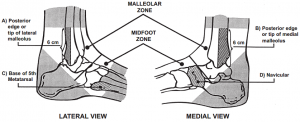Ankle Lateral Ligament Injury Assessment
Original Editor - Mariam Hashem
Top Contributors - Mariam Hashem, Kim Jackson, Tarina van der Stockt, Jess Bell and Olajumoke Ogunleye
Introduction[edit | edit source]
Lateral ankle ligament injruy is a common MSK condition representing 85% of ankle injuries [1]and has a high recurrencce rate[2]. Persisting post-injury symptoms such as swelling, impaired strength, instability (occasional giving way), and impaired balance responses for more than 12 months following the initial injury is defined as '' Chronic Ankle Instability-CAI''[3]. Up to 70% of patients report developing chronic ankle instability[4].
Risk Factors are classified into intrinsic and extinsic factors:
limited dorsiflexion, reduced proprioception, postural control deficiencies on SLS [5]
Additional factors that may contribute to an increased risk are reduced strength, coordination, cardiorespiratory, endurance, limited overall ankle joint ROM and decreased peroneal reaction time
What’s new: An increase in available data made it possible to identify female sex as well as potentially a lower BMI being risk factors for ankle sprains. Additionally, a recommendation is provided which was missing in the original guideline.
The highest incidence of LAS was found for aeroball, basketball, indoor volleyball, field sports and climbing[6].
Assessment[edit | edit source]
The Ottawa Ankle Rules to determine the need for radiographs in acute ankle injuries. If these rules were positive, the patient/athlete needs an x-ray to rule out fractures.
These rules are as follows:
1-Tenderness on plapation of :
A-posterior edge/dip of lateral malleoulus
B-Posterior edge/dip of medial malleoulus
C-Base of 5th metatarsal
D-Navicular
2-Inability to fully weight bear for normal 4 steps at time of injury or on examination
Subjective Assessment[edit | edit source]
- Mechanism of Injury and WB status. If an athelete was injured during a game, a decision has to be made on return to play based on the MOI and WB status.
- Contributing Factors
- When acute symptoms subside, the Cumberland Ankle Instability Tool can be used to predict the developmene tof CAI. A cut off 11.5 > unlikely to progress . less: high likely to progress
Objective Assessment:[edit | edit source]
Assessment of ligamentous laxity: anterior drawer, talar tilt and ankle syndesmosis.
- Swelling
- Isometric eversion/abduciton
Chronic ankle instability checklist:[edit | edit source]
Identifies a failed outcome of rehabilitation following an ATFL injury and increased risk of developing CAI.
ROM markers:
WB ankle DF < 34 degrees
Strength markers:
isometric hip abduction strength <34% of body weight
Balance-stability markers:
Single-leg balance test <10 seconds and on toes < 5 seconds without wobbliness.
SEBT: measures.
Performance markers:
unable to complete dingle leg drop landing
References[edit | edit source]
- ↑ Roos KG, Kerr ZY, Mauntel TC, Djoko A, Dompier TP, Wickstrom EA. The epidemiology of lateral ligament complex ankle sprains in National Collegiate Athletic Association sports. American journal of sports medicine. 2016.The American Journal of Sports Medicine Vol 45, Issue 1, pp. 201 - 209
- ↑ Roos KG, Kerr ZY, Mauntel TC, Djoko A, Dompier TP, Wikstrom EA. The epidemiology of lateral ligament complex ankle sprains in National Collegiate Athletic Association sports. Am J Sports Med.2017;45(1):201–209.
- ↑ Fernández-de-las-Peñas C, editor. Manual therapy for musculoskeletal pain syndromes: An evidence-and clinical-informed approach. Elsevier Health Sciences; 2015 Jun 17
- ↑ Anandacoomarasamy A, Barnsley L. Long term outcomes of inversion ankle injuries. Br J Sports Med 2005;39:e14; discussion e14.
- ↑ Kobayashi T, Yoshida M, Yoshida M, et al. Intrinsic Predictive Factors of Noncontact Lateral Ankle Sprain in Collegiate Athletes: A Case-Control Study. Orthop J SportsMed 2013;1:232596711351816.
- ↑ Waterman BR, Belmont PJ, Cameron KL, et al. Epidemiology of ankle sprain at the United States Military Academy. Am J Sports Med 2010;38:797–803.







